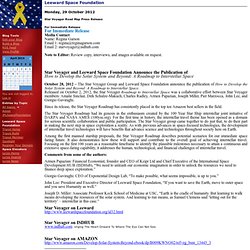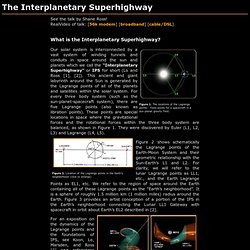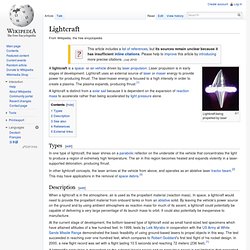

Colony Worlds. Space Dev. Co-op (@SpaceDevCoop) sur Twitter. Space Habitat Cooperative - Home. Living in Space & Space Tourism. Colonies (inc. Mars) & Space Stations. Wastes. Looking for Sponsors and Supporters. World Wide Cooperation - Space.
Biomes. Missions. Mars One. John Lee (jplspace) sur Twitter. Leeward Space Foundation. Monday, 29 October 2012 Star Voyager Road Map Press Release For Immediate Release Media Contact Name: Regina GarsonEmail 1: regina@reginagarson.comEmail 2: starvoyager@isdhub.com Note to Editor: Review copy, interviews, and images available on request.

Star Voyager and Leeward Space Foundation Announce the Publication of How to Develop the Solar System and Beyond: A Roadmap to Interstellar Space October 28, 2012 – The Star Voyager Group and Leeward Space Foundation announce the publication of How to Develop the Solar System and Beyond: A Roadmap to Interstellar Space. Released on October 2, 2012, the Star Voyager Roadmap to Interstellar Space was a collaborative effort between Star Voyager members: Amalie Sinclair, Dirk Schulze-Makuch, Charles Radley, Armen Papazian, Joseph Miller, Pier Marzocca, John Lee, and Giorgio Gaviraghi. Since its release, the Star Voyager Roadmap has consistently placed in the top ten Amazon best sellers in the field. Comments from some of the authors: Joseph D. JPL SPACE FOUNDATION. Mars. The Mars Society.
Robert Zubrin. Robert Zubrin (born April 9, 1952) is an American aerospace engineer and author, best known for his advocacy of the manned exploration of Mars.

He was the driving force behind Mars Direct—a proposal intended to produce significant reductions in the cost and complexity of such a mission. The key idea was to use the Martian atmosphere to produce oxygen, water, and rocket propellant for the surface stay and return journey. A modified version of the plan was subsequently adopted by NASA as their "design reference mission".
He questions the delay and cost-to-benefit ratio of first establishing a base or outpost on an asteroid or another Apollo Program-like return to the Moon, as neither would be able to provide all of its own oxygen, water, or energy; these resources are producible on Mars, and he expects people would be there thereafter.[1] Zubrin lives in Lakewood, Colorado; he has two daughters, Rachel and Sarah.
Robert Zubrin, "The Reason Why Space is Really Important" Moon. Space Exploration is Now a Global Issue. Exploration & commercial use of space is not just for ESA, NASA, JAXA, or ROSCOSMOS; it is a global issue. Exactly how we explore asteroids, moons, mars and so forth is a matter of budget and time frames. We may use Human or robotic or combined exploration methods.
Amazon. Space Solar Power. Space Elevator.
Scientific Exploration of Space. Exploring & Scientific Use of Space. Space Law. Future Space Technologies. Future Space Technologies. Future plans on colonization & exploration of nearby stars. About Centauri Dreams. Tracking Research into Deep Space Exploration Alpha Centauri and other nearby stars seem impossible destinations not just for manned missions but even for robotic probes like Cassini or Galileo.

Nonetheless, serious work on propulsion, communications, long-life electronics and spacecraft autonomy continues at NASA, ESA and many other venues, some in academia, some in private industry. The goal of reaching the stars is a distant one and the work remains low-key, but fascinating ideas continue to emerge. This site will track current research. I’ll also throw in the occasional musing about the literary and cultural implications of interstellar flight.
Above: Alpha and Beta Centauri are sometimes known as ‘The Pointers,’ since they lead the eye to the Southern Cross. I’m Paul Gilster. I don’t think we’ll see a robotic interstellar probe until late in this century, if then, but that doesn’t matter. I’ve been a full-time writer for the past twenty years. Exploring & Scientific Use of Space. People in space (future) There was a Salon article that talked about manned space flight ending just because the space shuttle was being retired.

There is certainly a lot more that can be done with robotic exploration of space but the article is completely wrong to predict the end of manned space flight. In fact we are at the beginning of a boom in sending people into space. Human spaceflight is not ending. NASA getting out of space shuttles is not relevant. I think we are on the cusp of big changes in technology both for space and for energy.
Spacex Falcon Heavy should be ready in 2013. Bigelow Aerospace, who make the inflatable space stations, is getting a big expansion, increasing staff by 11 times and increasing production Combined the two will be able to launch space stations with volumes larger than the International Space station in a single launch. Bigelow will be adding an expansion module onto the ISS and it could rotate (providing gravity like centrifuge forces.)
Erika DeBenedictis- unlimited space exploration. Unlimited exporloration of Solar System. Interplanetary Superhighway: description. See the talk by Shane Ross!

RealVideo of talk: [56k modem] [broadband] [cable/DSL] What is the Interplanetary Superhighway? Our solar system is interconnected by a vast system of winding tunnels and conduits in space around the sun and planets which we call the “Interplanetary Superhighway” or IPS for short (Lo and Ross [1], [2]). This ancient and giant labyrinth around the Sun is generated by the Lagrange points of all of the planets and satellites within the solar system. For every three body system (such as the sun-planet-spacecraft system), there are five Lagrange points (also known as libration points). Figure 2 shows schematically the Lagrange points of the Earth-Moon System and their geometric relationship with the Sun-Earth’s L1 and L2. Interplanetary Superhighway Makes Space Travel Simpler.
Interplanetary Superhighway Makes Space Travel Simpler A "freeway" through the solar system resembling a vast array of virtual winding tunnels and conduits around the Sun and planets, as envisioned by an engineer at NASA's Jet Propulsion Laboratory, Pasadena, Calif., can slash the amount of fuel needed for future space missions.

Image right: Artist's concept of interplanetary superhighway.+ Click for full image. Sun & planets formed in differently way? Quick Transit Map. Helium-3. Helium-3 (He-3) is a light, non-radioactive isotope of helium with two protons and one neutron.

It is rare on Earth, and it is sought for use in nuclear fusion research. The abundance of helium-3 is thought to be greater on the Moon (embedded in the upper layer of regolith by the solar wind over billions of years),[1] though still lower in quantity (28 ppm of lunar regolith is helium-4 and from one ppb to 50 ppb is helium-3)[2][3] than the solar system's gas giants (left over from the original solar nebula). Helium-3 was hypothesized to be a radioactive isotope until helions were also found in samples of natural helium, which is mostly helium-4, taken both from the terrestrial atmosphere and from natural gas wells.
This was done by Luis W. Alvarez and Robert Cornog in cyclotron experiments at the Lawrence Berkeley National Laboratory in California in 1939.[5] Physical properties[edit] [edit] Neutron detection[edit] n + 3He → 3H + 1H + 0.764 MeV. Lightcraft. Lightcraft being propelled by laser A lightcraft is a space- or air-vehicle driven by laser propulsion.

Laser propulsion is in early stages of development. Lightcraft uses an external source of laser or maser energy to provide power for producing thrust. The laser/maser energy is focused to a high intensity in order to create a plasma. The plasma expands, producing thrust.[1] A lightcraft is distinct from a solar sail because it is dependent on the expansion of reaction mass to accelerate rather than being accelerated by light pressure alone. Types[edit] In one type of lightcraft, the laser shines on a parabolic reflector on the underside of the vehicle that concentrates the light to produce a region of extremely high temperature.
Commercial Space Transportation. Space Shuttle Discovery - 360VR Images.